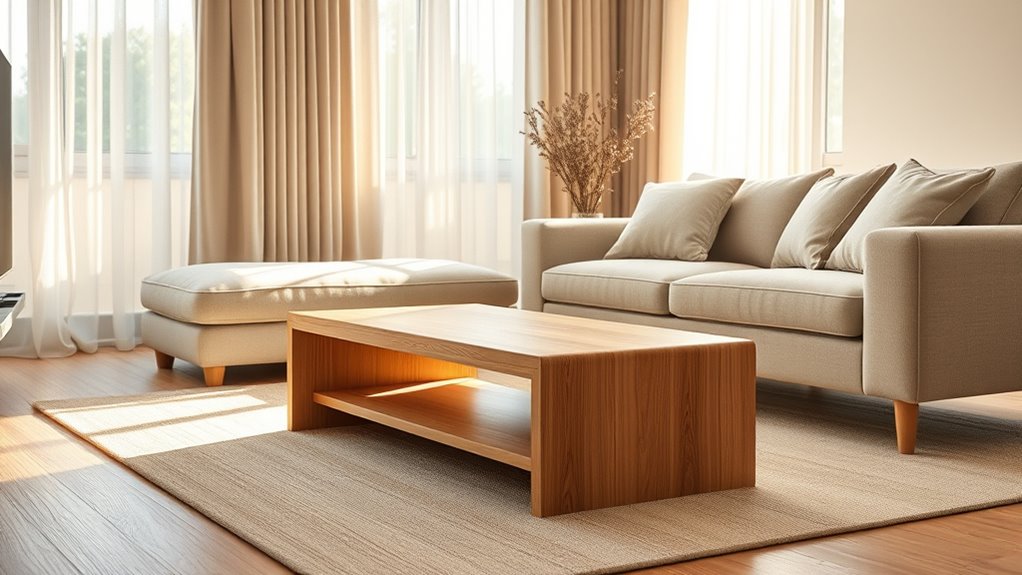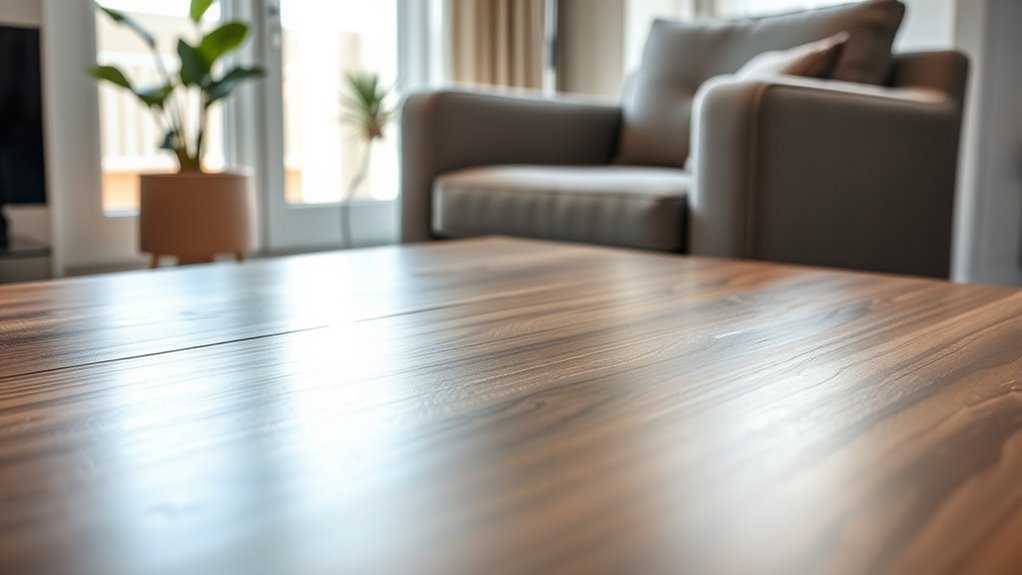To identify formaldehyde in furniture, check labels or product descriptions for low-emission or formaldehyde-free marks, especially on pressed wood items like particleboard or plywood. Reduce exposure by ventilating your space often, using air purifiers, and letting new furniture air out before bringing it inside. Choosing solid wood or certified low-emission products also helps. If you want to learn more about safe options and effective ways to manage formaldehyde levels, keep exploring these tips.
Key Takeaways
- Look for labels indicating formaldehyde-free or low-emission certifications on furniture.
- Choose solid wood or non-pressed materials to minimize formaldehyde exposure.
- Increase indoor ventilation and use air purifiers to reduce VOC levels from off-gassing furniture.
- Air out new furniture in well-ventilated areas before bringing it indoors.
- Regularly clean surfaces and maintain low humidity to slow VOC release and improve air quality.

Have you ever wondered if the furniture in your home could be quietly releasing harmful chemicals? It’s a valid concern, especially considering how much time you spend indoors. Formaldehyde, a common chemical used in manufacturing particleboard, plywood, and other pressed wood products, can off gas over time, impacting your indoor air quality. When furniture contains formaldehyde-based resins, it releases volatile organic compounds (VOCs) into the air, which you breathe in daily. This continuous off gassing can lead to health issues like respiratory irritation, allergies, or even longer-term concerns. Recognizing the signs and understanding how to reduce exposure is essential for maintaining a healthier home environment.
Furniture may emit harmful chemicals like formaldehyde, affecting indoor air quality and health.
Improving your indoor air quality starts with awareness. You’ll want to identify furniture that might be emitting formaldehyde, especially if it’s new or made from pressed wood materials. Look for labels or product descriptions indicating formaldehyde-free certification or low-emitting materials. If replacement isn’t an option, focus on off gassing reduction techniques. Increasing ventilation is one of the simplest ways to dilute indoor VOCs. Open windows regularly, use exhaust fans, and consider installing air purifiers equipped with activated carbon filters designed to absorb VOCs. These steps not only help clear out formaldehyde but also improve overall air quality, making your space healthier.
Another effective strategy involves choosing furniture made from natural, solid wood or other non-toxic materials. When purchasing new furniture, ask retailers about the materials used and opt for products with low or no formaldehyde emissions. Applying sealants or finishes that block VOC release can also slow down off gassing, giving your home a break from ongoing chemical exposure. Additionally, maintaining low humidity levels helps prevent the buildup of VOCs in the air, as moisture can accelerate off gassing processes. Regularly checking for product certifications that verify low emissions can further guide you toward healthier choices.
It’s worth noting that the process of formaldehyde off gassing decreases over time. New furniture tends to emit higher levels initially, but this diminishes with proper ventilation and care. You can accelerate this reduction by letting furniture air out in well-ventilated spaces before bringing it indoors. Regular cleaning and dusting also reduce surface residues that might contain formaldehyde or other VOCs, further supporting better indoor air quality. By staying informed and adopting these practices, you actively minimize the risks associated with formaldehyde in furniture, creating a safer, healthier environment for you and your family.
Frequently Asked Questions
How Long Does Formaldehyde Off-Gas From Furniture?
The chemical off-gassing from furniture usually lasts from a few days to several years, depending on the material and conditions. You should focus on ventilation strategies, like opening windows and using air purifiers, to reduce formaldehyde levels. Keep in mind, new furniture tends to off-gas the most in the first few weeks, so proper ventilation during this period helps minimize your exposure and improves indoor air quality.
Are There Specific Furniture Brands With Low Formaldehyde Levels?
Did you know that choosing furniture from certified eco-friendly, low emission brands can considerably reduce your formaldehyde exposure? Some brands prioritize low formaldehyde levels, helping you breathe easier and minimize health risks. Look for labels like GREENGUARD Gold or FSC certification, which indicate safer, low-emission furniture options. By selecting these brands, you actively lower indoor toxins and create a healthier home environment for you and your family.
Can Indoor Plants Reduce Formaldehyde Exposure From Furniture?
You might wonder if indoor plants can lower formaldehyde levels. While plant selection matters, certain plants like spider plants, snake plants, and peace lilies are known to improve indoor air quality. These plants absorb formaldehyde from indoor air, helping to reduce your exposure from furniture. Keep in mind, though, that plants alone shouldn’t be your only strategy—ventilation and choosing low-emission furniture also play vital roles.
What Are the Symptoms of Formaldehyde Exposure in Furniture?
Did you know that over 50% of indoor air pollution comes from furniture? If you’re exposed to formaldehyde, you might notice health symptoms like eye, nose, and throat irritation, along with coughing or skin rashes. Prolonged exposure risks include respiratory issues and allergic reactions. Stay alert to these signs, and make certain proper ventilation and low-emission furniture to reduce your risk of health problems.
How Often Should I Test My Furniture for Formaldehyde?
You should test your furniture for formaldehyde at least once a year, especially if it’s new or older furniture with a shorter lifespan. Testing frequency depends on factors like usage and environmental conditions. Regular testing helps you catch elevated formaldehyde levels early, reducing health risks. If your furniture is made from pressed wood or composite materials, more frequent checks are advisable to guarantee safe indoor air quality over its lifespan.
Conclusion
By understanding how formaldehyde sneaks into your furniture, you hold the power to reduce your exposure. Think of it as shining a light into a hidden corner—suddenly, those lurking hazards become clear. Ventilate your space, choose low-emission products, and stay informed. Taking these simple steps transforms your home from a silent threat into a safe haven, turning the tide on formaldehyde’s silent invasion and protecting your health with confidence.









